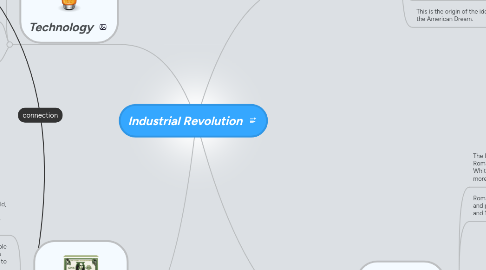
1. Technology
1.1. New technological innovations allowed for humans to execute and complete activities in a much more efficient way.
1.2. With growing technology, massive production numbers followed. With this comes more supply, which affects prices, which affects how the economy grows, etc.
1.3. The Steam Engine, the Spinning Jenny, the Cotton Gin, the Sewing Machine, the development of steel, the exansion of the Railroads, the Automobile are just a short list of world changing technologies introduced at this time.
2. Economics
2.1. With the advancement of technology in the manufacturing field, companies and businesses had to advance as well. This meant the Industrialization of economies as well as the growth of the factory system.
2.2. With the growth of the factory system, conditions in which people worked in gradually became worse and worse. Working in filth, in unsafe conditions, and with zero guarantee that you were going to keep your job were normal.
2.3. Workers in the factories ranged from men to women, and from adult to child. Child Labor laws were a direct effect of these working conditions of the Industrial Revolution.
2.4. Organized labor was born, and grew to be a substantial power in America. They are credited with arguing for, and receiving, the 40 hour work week, weekends, safer working conditions, health care, and a numbner of other things.
3. Religion
3.1. Before the Industrial Revolution, men were normally very involved with their church or community.
3.2. After the advent of the Industrial Revolution, work became more important than God to especially men.
3.3. Desmond Tutu: “When the missionaries came to Africa they had the Bible and we had the land. They said, 'Let us pray.' We closed our eyes. When we opened them we had the Bible and they had the land.”
3.4. The dynamic of religion in the community had to begin sharing with the idea or notion of working and taking care of the family.
3.5. This is the origin of the idea of the American Dream.
4. Literature
4.1. The Industrial Revolution is the time of Romanticism Literature (Nathaniel Hawthorne, Walt Whitman, Emily Dickenson, Mark Twain, and more).
4.2. Romanticism refers to the style of art, literature, and philosophies that developed during the 18th and 19th centuries, peaking during 1800-1850.
4.3. Characteristics of Romanticism
4.3.1. 1. Imagination and emotion are more important than reason and formal rules; imagination is a gateway to transcendent experience and truth.
4.3.2. 2. Along the same lines, intuition and a reliance on “natural” feelings as a guide to conduct are valued over controlled, rationality.
4.3.3. 3. Romantic literature tends to emphasize a love of nature, a respect for primitivism, and a valuing of the common, "natural" man; Romantics idealize country life and believe that many of the ills of society are a result of urbanization.
4.3.4. 4. Romantics were interested in the Medieval past, the supernatural, the mystical, the “gothic,” and the exotic.
4.3.5. 5. Romantics were attracted to rebellion and revolution, especially concerned with human rights, individualism, freedom from oppression.
4.3.6. 6. There was emphasis on introspection, psychology, melancholy, and sadness. The art often dealt with death, transience and mankind’s feelings about these things. The artist was an extremely individualistic creator whose creative spirit was more important than strict adherence to formal rules and traditional procedures.
